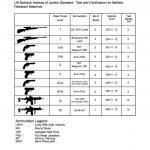NIJ 0108.01 US
The purpose of this standard NIJ 0108.01 is to establish minimum performance requirements and methods of test for ballistic resistant protective materials. This standard supersedes NIJ standard- 0108.00, Ballistic Resistant Protective Materials, dated December 1981. This revision adds threat level III-A and establishes threat level classifications that are consistent with other NIJ standards for ballistic protection.

Further Information on NIJ 0108.01:
Scope
This standard is applicable to all ballistic restraint materials (armour) intended to provide protection against gunfire, with the exception of police body armor and ballistic helmets, which are the topic of individual NIJ performance standards. Many different types of armor are now available that range in ballistic resistance from those designed to protect against small caliber handguns to those designed to protect against high powered rifles. Ballistic resistant materials are used to fabricate portable ballistic shields, such as ballistic clipboards for use by a police officer, to provide ballistic protection for fixed structures such as control rooms or guard stations, and provide ballistic protection for the occupants of vehicles. The ballistic resistant materials used to fabricate armour include metals, ceramics, transparent glazing, fabric, and fabric reinforced plastics. They are used separately or in combination depending on the intended threat protection.
The ballistic threat posed by a bullet depends among other things on its composition, shape, caliber, mass and impact velocity. Because of the wide variety of cartridges available in a given caliber, and because of the existence of hand loads, armour that will defeat a standard test round may or may not defeat other loadings in the same caliber. For example, an armour that prevents penetration by a 357-magnum test round may or may not defeat a 357 Magnum round with higher velocity. Similarly, for identical striking velocities, non-deforming or armour piercing pose a significantly greater penetration threat than a equivalent lead core round of the same caliber. The test ammunitions specified in this standard represent common threats to the law enforcement community.
Email or call us on +44(0)1981 257000

